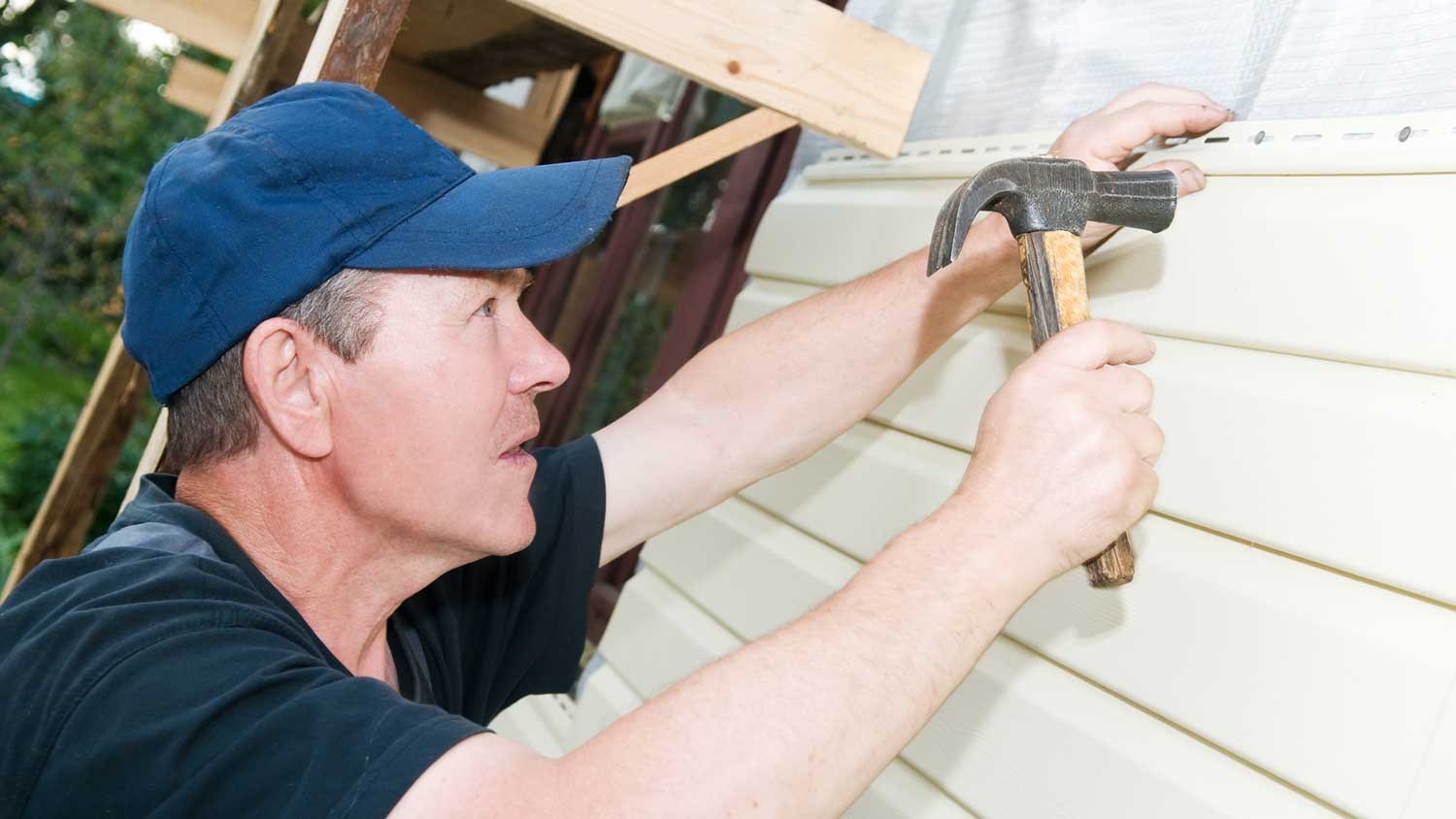
New siding improves curb appeal, increases home value, and insulates your home. Learn about fiber cement installation costs in Raleigh.
A hole in your siding doesn’t have to mean a hole in your wallet


Vinyl siding repair costs $915 on average, but hiring a pro will ensure repairs seamlessly integrate into your home.
Hiring a vinyl repair professional will ensure that the job is done right the first time and avoid any further costs.
Hiring a pro to repair vinyl siding can come with the added benefit of an expert inspection, which can assess if there’s any permanent damage to your home like mold, insects, or mildew.
Vinyl siding can last for 40 years with proper care. However, it’s susceptible to bumps and scrapes along the way. A hole in your vinyl siding—whether from a falling tree branch, hail, or an errant rock ejected from the lawn mower—takes less time to fix than running to the store for materials. Follow along to learn all you need to know about how to repair vinyl siding.
A hole in your vinyl siding isn’t just unsightly; it can lead to expensive and complicated repairs for your home. Water that gets behind vinyl siding may have a difficult time getting out. Mold, mildew, insects, and foul odors love when siding repair goes unfinished.
If you think the hole in your siding is more than a few weeks old, consider requesting an inspection from a mold testing company before continuing.
Little holes and scratches can appear benign when they happen. However, vinyl siding contracts and expands with temperature changes. What was once a tiny blemish can stretch and crack open. For that reason, regular inspection and repair of your vinyl siding are essential.
The cost to repair a small hole in vinyl siding will range between $50 and $100 if you hire a pro. Although, you may be able to find a better estimate from a local siding repair company if you have several spots that need repair at the same time.
That cost pales in comparison to the price of replacing siding. Repairing vinyl siding yourself costs only around $10 to $25, depending on the method of repair and the tools you may already own.
It’s not unusual to discover one or more of the seven signs that your vinyl siding needs replacing as it nears the end of its expected lifespan or after severe weather events. If you notice water in the house, warped, fallen, or loose pieces of siding, numerous holes or large cracks in your siding, or a flaky or powdery texture, it’s time to assess and plan repairs.

However, you may encounter situations where simple repairs are no longer sufficient to protect your home. If your siding is already older than its expected lifespan and not in great shape, you may be better off replacing it—either the broken piece or all of it.

After discovering that your siding requires some repairs, there are four simple repair methods to consider.
The hole size is the most important factor in determining which repair method your siding requires. Holes less than a 1/2 inch in diameter may need a dab of caulk to cover up the blemish. You can tackle holes no larger than 1 inch across with a vinyl siding patch kit. Larger holes will require one of the two other methods described below.
This caulking method can effectively repair siding holes up to 1/2 inch in diameter.
Clean the area surrounding the hole, several inches in each direction, with mild soap and water. Let it dry.
Skip this step if you’re just filling a surface crack on the siding that doesn't penetrate the thickness of the piece. Use a vinyl siding zip tool to release the lower lip of the damaged siding piece. To do this, slip the curved edge of the zip tool under one end of the siding’s lower lip and simultaneously slide the device to one side while applying downward pressure. Continue this motion until several feet of the siding’s edge disengages from the below piece.
Reach up and behind the hole and adhere a piece of duct or foil tape to the siding, creating a backing for the caulk. Cover the hole with the sticky side facing out.
Reinstall the lower lip of the siding piece. Use the zip tool to hook the siding’s lower edge, and pull it down with the tool while pushing the bottom of the piece back into its original position. As you move along the edge, you’ll feel the lip engage with the section below.
Squeeze enough paintable caulk into the hole and onto the surface of the tape to cover the spot. You may be able to find caulk in the same color as your siding. Otherwise, you’ll need a paintable caulk.
Let the caulk dry for a few hours. Follow the instructions on the caulk label.
Use a utility knife with a sharp blade to trim any excess caulk until the patch feels smooth. It may help to remove the blade from the knife tool.
Paint your vinyl siding a bit by touching up the spot. Use exterior-grade paint to match the siding.
For slightly larger holes, up to 1 inch in diameter, vinyl siding patch kits can hide blemishes and provide excellent protection from future damage. Follow the specific directions for your repair kit for vinyl siding. They’ll resemble the following steps.
Clean the area around the hole, several inches in each direction, with soap and water.
Allow the area to dry thoroughly.
Remove the backing on the self-adhesive, lower-surface patch, and adhere it over the hole. Press firmly on the patch for several seconds.
Remove the backing on the larger, upper-surface patch, and press it firmly in place over the first patch.
Touch up the spot with exterior-grade paint to match the siding.

Holes larger than 1 inch in diameter will struggle to remain weather-tight with the above repair methods. This next fix provides a durable and lasting repair for any size hole.
Purchase a sample piece or a whole piece of vinyl siding that best matches the color of your home’s siding. Finding a perfect match is likely not an option due to the normal color fading of vinyl siding.
Find an inconspicuous location where you can remove a two-foot section of your existing siding. You’ll use this piece as your patch. It will better match the siding where the repair is taking place, but you’ll use your brand-new piece of siding from the previous step to patch this section later.
Remove the patch piece by making vertical cuts (no wider than two feet apart) through the piece with a sharp utility knife.
Use your zip tool to disengage the patch and siding piece above it.
Cut the top and bottom rolled edges with aviation snips.
Use a pry bar to remove any nails holding the patch to the wall by reaching under it with the tool.
On the top and bottom of the patch are rolled-over or folded-over edges that are difficult to cut with a utility knife. Use the snips to prep the patch for reinstallation at the hole location by cutting away 1 1/2 to 2 inches of the rolled edges on the piece.
At hole location, cut the damaged section away to a width 2 inches shorter than the patch you now have. Use the same method as above to remove the section from the wall.
Insert the patch into the new void and snap the bottom edge to the siding below the patch.
Nail the patch in place using at least two roofing nails. Hold the siding piece above the patch up and out of the way of your hammer. Stop short of driving the nails all the way in to leave the part loose enough to expand and contract.
Use the zip tool to re-engage the siding above the patch.
Finally, grab the sample piece from the first step and install it where the patch removal left an empty section. Use your zip tool and nails accordingly.
Don’t hesitate to call a nearby handyperson for help if the repair is particularly tricky or located beyond safe reach.
Most of us don’t go out and try to make holes in our home’s siding, but it does happen. There’s not much we can do about forces of nature, flying lawn-mower rocks, or some other projectile accidentally causing damage. Fortunately, the fixes aren’t too tricky, and they’re strong enough and look good enough to suffice until it’s time to replace the siding on the whole house.
A few siding maintenance tips can help you stretch that time as far as possible.
Clean your vinyl siding annually with mild soap and hose water. You can power wash vinyl siding, but take extra care to avoid getting water under it.
Inspect your siding at least twice a year after seasonal changes. Look for cracks, holes, water intrusion, and caulk deterioration.
When you find holes, repair them as soon as the weather allows.
Replace old caulk as soon as you notice deterioration.
Keep trees and bushes near the house trimmed to avoid scratches or damage from swaying or falling branches.
Next time you install vinyl siding, ask your contractor about foam-insulated siding. It can reduce some of the damages or holes that happen under normal conditions and help lower your energy bill.
From average costs to expert advice, get all the answers you need to get your job done.

New siding improves curb appeal, increases home value, and insulates your home. Learn about fiber cement installation costs in Raleigh.

Vinyl siding adds charm while also protecting from North Carolina's humidity. Learn about average vinyl siding installation costs in Raleigh.

Siding repairs add value to Raleigh homes by securing them against the region's hot, humid summers and wet winters. Learn how much siding repairs cost in Raleigh.

Are you wondering what clapboard siding looks like? This explanation of clapboard siding will help you discover when to use clapboard siding, clapboard siding pros and cons, costs, and styles.

Regularly cleaning vinyl siding helps your house look better and last longer. Find out how you can tackle this DIY project on your own.

Wondering why your vinyl siding is wavy? Chances are the installation is to blame. But the issue could be sunlight, heat, or foundation issues.